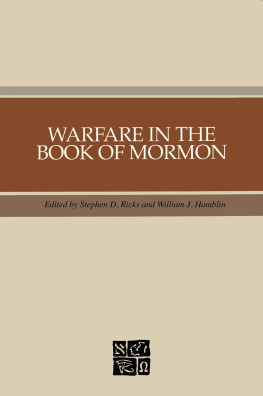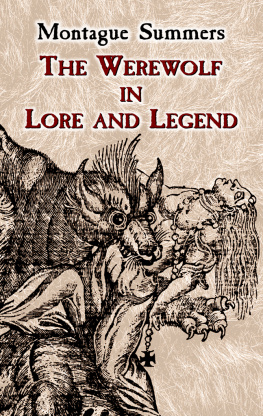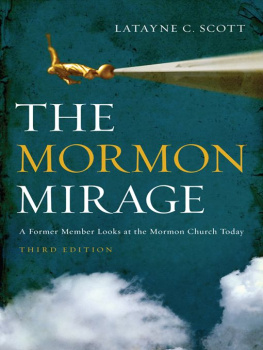Mould Tom - Latter-day Lore: Mormon Folklore Studies
Here you can read online Mould Tom - Latter-day Lore: Mormon Folklore Studies full text of the book (entire story) in english for free. Download pdf and epub, get meaning, cover and reviews about this ebook. City: Salt Lake City, year: 2013, publisher: The University of Utah Press, genre: Religion. Description of the work, (preface) as well as reviews are available. Best literature library LitArk.com created for fans of good reading and offers a wide selection of genres:
Romance novel
Science fiction
Adventure
Detective
Science
History
Home and family
Prose
Art
Politics
Computer
Non-fiction
Religion
Business
Children
Humor
Choose a favorite category and find really read worthwhile books. Enjoy immersion in the world of imagination, feel the emotions of the characters or learn something new for yourself, make an fascinating discovery.
- Book:Latter-day Lore: Mormon Folklore Studies
- Author:
- Publisher:The University of Utah Press
- Genre:
- Year:2013
- City:Salt Lake City
- Rating:4 / 5
- Favourites:Add to favourites
- Your mark:
- 80
- 1
- 2
- 3
- 4
- 5
Latter-day Lore: Mormon Folklore Studies: summary, description and annotation
We offer to read an annotation, description, summary or preface (depends on what the author of the book "Latter-day Lore: Mormon Folklore Studies" wrote himself). If you haven't found the necessary information about the book — write in the comments, we will try to find it.
Latter-day Lore: Mormon Folklore Studies — read online for free the complete book (whole text) full work
Below is the text of the book, divided by pages. System saving the place of the last page read, allows you to conveniently read the book "Latter-day Lore: Mormon Folklore Studies" online for free, without having to search again every time where you left off. Put a bookmark, and you can go to the page where you finished reading at any time.
Font size:
Interval:
Bookmark:

| Publication of this work was supported by a Publication Grant from THE C HARLES R EDD C ENTER FOR W ESTERN S TUDIES AT B RIGHAM Y OUNG U NIVERSITY |
and the C OLLEGE OF H UMANITIES AT B RIGHAM Y OUNG U NIVERSITY
Copyright 2013 by The University of Utah Press. All rights reserved.
| The Defiance House Man colophon is a registered trademark of the University of Utah Press. It is based on a four-foot-tall Ancient Puebloan pictograph (late PIII) near Glen Canyon, Utah. |
17 16 15 14 13 1 2 3 4 5
L IBRARY OF C ONGRESS C ATALOGING-IN -P UBLICATION D ATA
Latter-day lore : Mormon folklore studies / edited and with introductions by Eric A. Eliason and Tom Mould.
pages cm
Includes bibliographical references and index.
ISBN 978-1-60781-284-5 (pbk. : alk. paper) ISBN 978-1-60781-285-2
1. Mormons Folklore. I. Eliason, Eric A. (Eric Alden), 1967 editor of compilation.
II. Mould, Tom, 1969 editor of compilation.
GR105.L36 2013
398.20892893 dc23
2013025402
Page 583 should be considered an extension of this copyright page.
Printed and bound by Sheridan Books, Inc., Ann Arbor, Michigan.

For William A. Bert Wilson
Addendum
Austin E. Fife and James M. Fife
The logical place to begin our thanks is with the contributors to this volume, the scholars whose work over the past century has built a robust body of scholarship about the folklore of and about Mormons in the United States and beyond. We are all the beneficiaries of this work, but none more so than the editors of this book who relied on the labor of scholars past and present to construct a history and highlight the scope of Mormon folklore studies. The contributors names can all be found in the table of contents as well as tied directly to their contributions in the text of this book.
As deep as our debt is to these scholars, it is the people they encountered in the fieldthe men, women, and children, most Mormon, some notwho deserve the greatest acknowledgment. The study of folklore is, after all, a study of people and the rich, complex, and various traditions that they have created, maintained, reshaped, critiqued and above all else, shared, with their families, friends, peers, community members, and, ultimately, scholars. In many of the studies in this book, those names and faces are blurred, but as scholars began to recognize folk artists and practitioners as worthy of individual note, those names begin to emerge. It would be impossible to name all of these people here, but as you read, we hope you will consider the powerful contributions of these distinct individuals and remember their names as worthy of praise.
None of these studies could have been amassed without the generous permissions granted by editors and family members who gave both formal permissions and informal support for the project. Those editors include Perry Cartwright, University of Chicago Press; Sharon Day, University of Utah Press; Thomas A. DuBois and James P. Leary, Journal of American Folklore; Jawaharlal Handoo, Partner Zooni Publications; LaRita Johnson, Marriage and Families Magazine; Kathleen Kornell, University of Illinois Press; Lori Levinson, Dialogue: A Journal for Modern Thought; Robin Maier, Association of American Geographers; Elliot Oring, Western Folklore; Annette Samuelsen, BYU Studies; and Patricia Zline, University Press of America.
Securing these permissions, formatting documents, organizing submissions, and handling a thousand other vital tasks in the production of a collection such as this were done with absolute efficiency and professionalism by the amazing student editors at the BYU Humanities Publication Center: Christina Champenois, Melinda Keefe, Whitney Lindsley, Matthew Rayback, Jennifer Scheiving, Caitlin Schwanger, Sara Seamons, Kayla Swan, Michele Lyons, Emily Smith, and Brittany Bruner. From start to finish there was Mel Thorne, who handled every task thrown to him with ease and graciousness, ensuring that the manuscript we sent to our editors at the University of Utah Press was clear, coherent, and complete.
We also appreciate the close reading and valuable feedback by reviewers Elaine Thatcher and Leonard Primiano, as well as the thoughtful comments from Danille Christensen on the introduction to the book. Their comments helped us create a book that could speak to multiple audiences, Mormon and non-Mormon, folklorist and non-folklorist alike.
Through it all, there was John Alley. Far more than an editor, John has been an advocate and sage advisor. Not only did he help shepherd this book from idea to manuscript to published work, but he drew upon his extensive understanding of the field of folklore and Mormon studies to provide valuable feedback in the shaping of this book. To John, we are eternally grateful.
Finally, there are personal friends and family to whom we owe our deep gratitude for their enduring support, friendship and love. For Tom, there is Brooke and their children Lily and Jack. For Eric, there is Stephanie and their children Shelby, Caleb, Noah, and Samuel. For both of us there is Bert Wilson, to whom this book is dedicated. Professionally and personally, Bert has been a leader, friend, and mentor, and for this we owe him our profound thanks.
Every culture has an origin myth. Most have multiple origin mythssome that tumble over each another in similarity, some that sidle alongside each other only to diverge in dramatic ways, and some that face off in stark contradiction. Academic disciplines, even subfields of those disciplines, have their origin myths, too, and the study of Mormon folklore is no different.
One origin story of Mormon folklore studies can be told through the study of the Three Nephites. This story begins in 1892, with the publication of Mormon Superstition by the Reverend David R. Utter. Appearing in The Folk-Lorist, his brief articleno more than a note at a mere 235 wordsserved as a shot across the bow in introducing the deep tradition of supernatural belief among Mormons through the belief in three apostles from the Book of Mormon who chose to remain on earth until the time of Jesuss return. Utters account is as follows:
They all call the Indians of this country Lamanites, from the story of the Book of Mormon, that they were descended from Laman, one of the sons of Lehi, who came from Jerusalem to Chili about 600 BC . That migration, however, was not the first peopling of America. A company started from the Tower of Babel at the time of the confusion of tongues, and came by way of Siberia and Alaska into North America. At the time of the Crucifixion, Christ came to America, and gave an epitome of the Gospel to the people here, and just as he was leaving them, three petitioned to remain on the earth, till he came again. Their request was granted, and so they remain. All of this you may read in the Book of Mormon. Now, the Mormons took up this Wandering Jew legend with avidity, and many of the saints now living tell that they have, at different times, seen one or more of these immortal Nephites. A daughter of Brigham Young, now a good Unitarian, has told me that her father told, with great and solemn pleasure, of an interview that he had with one of these remaining apostles in Liverpool, when he was there on a mission. The apostle met him at the chapel door, an old man with a long gray beard, made himself known, and spoke many encouraging and helpful words.
Font size:
Interval:
Bookmark:
Similar books «Latter-day Lore: Mormon Folklore Studies»
Look at similar books to Latter-day Lore: Mormon Folklore Studies. We have selected literature similar in name and meaning in the hope of providing readers with more options to find new, interesting, not yet read works.
Discussion, reviews of the book Latter-day Lore: Mormon Folklore Studies and just readers' own opinions. Leave your comments, write what you think about the work, its meaning or the main characters. Specify what exactly you liked and what you didn't like, and why you think so.








